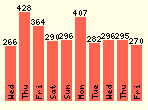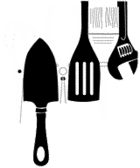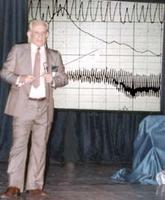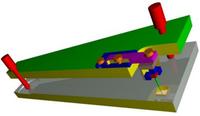|
This is my dynamic, frequently updated homepage. This is a NewsLog, also known as a WebLog or Blog.
Everything is evolving, so don't assume too much.
People to watch:
Adina Levin
Andrius Kulikauskas
Britt Blaser
Catherine Austin Fitts
Chris Corrigan
Clay Shirky
Dan Gillmor
Dave Pollard
David Allen
David Weinberger
Dewayne Mikkelson
Dina Mehta
Doc Searls
Elisabet Sahtouris
Elizabeth Lawley
Euan Semple
Florian Brody
Frank Patrick
Gen Kenai
George Dafermos
George Por
Graham Hancock
Greg Elin
Hazel Henderson
Heiner Benking
Inspector Lohman
Jean Houston
Jerry Michalski
Jim McGee
Jim Moore
John Abbe
John Perry Barlow
John Robb
Joi Ito
Jon Husband
Jon Lebkowsky
Jon Udell
Jonathan Peterson
Judith Meskill
Julian Elvé
Julie Solheim
Kevin Marks
Lawrence Lessig
Leif Smith
Letecia Layson
Lilia Efimova
Lisa Rein
Marc Canter
Mark Oeltjenbruns
Mark Pilgrim
Mark Woods
Martin Dugage
Martin Roell
Mary Forest
Matt Mower
Max Sandor
Michael Fagan
Mike Owens
Mikel Maron
Mitch Kapor
Mitch Ratcliffe
Nathalie dArbeloff
Netron
Noam Chomsky
Paul Hughes
Peter Kaminski
Phil Wolff
Philippe Beaudoin
Ray Ozzie
Raymond Powers
Rebecca Blood
Roger Eaton
Roland Tanglao
Ross Mayfield
Scott Lemon
Sebastian Fiedler
Sebastien Paquet
Skip Lancaster
Spike Hall
Steven Johnson
Stuart Henshall
Thomas Burg
Thomas Madsen-Mygdal
Thomas Nicholls
Timothy Wilken
Todd Suomela
Tom Atlee
Tom Munnecke
Tom Tomorrow
Ton Zijlstra
Lionel Bruel
Loic Le Meur
Nancy White
Mark Frazier
Merlin Silk
Robert Paterson
Colby Stuart
Nova Spivack
Dan Brickley
Ariane Kiss
Vanessa Miemis
Bernd Nurnberger
Sites to watch:
Electronic Frontier Foundation
Co-intelligence Institute
Free Expression Network
Collective Intelligence
Action without borders
Manufacturing Dissent
Explorers Foundation
Disclosure Project
ThoughtsOnThinking
Forbidden Science
Emergent by Design
Greater Democracy
Global Ideas Bank
Independent Media
Space Collective
Friendly Favors
Escape Velocity
Disinformation
Collective Web
WorldChanging
YES Magazine
Disinfopedia
NotThisBody
MetaFilter
Webcamorama
BoingBoing
Smart Mobs
Do No Harm
Imaginify
FutureHi
Openworld
Nanodot
HeadMap
Rhizome
Absara
Edge
Junto
French:
Emmanuelle
Manur
Elanceur
Loeil de Mouche
IokanaaN
Blog d'Or
Le Petit Calepin
GeeBlog
Absara
Guillaume Beuvelot
Ming Chau
Serge Levan
Jean Michel Billaut
C'est pas Mécanique

I live in Toulouse, France where the time now is:
02:01
Unique Readers:

Primarily
Public Domain
Everything I've written here is dedicated to the
Public Domain.

The quotes from other people's writings, and the pictures used might or might not be copyrighted, but are considered fair use. Thus, overall, this weblog could best be described as being:
Primarily Public Domain. |
Syndication:
 ![Validate my RSS feed [Valid RSS]](http://www.newciv.org/pic/valid-rss.png)
|
| Wednesday, January 14, 2004 |  |
|
|
|
 The pictures from Mars are pretty damn cool. Particularly the 360 degree QTVR version. Just like being there, I suppose. Seems to be lots of things to explore. As far as red rocks go. One of the ones lying just in front of the lander looks almost artificially angled to me. Would be fun if they had landed on top of an old ruin. The pictures from Mars are pretty damn cool. Particularly the 360 degree QTVR version. Just like being there, I suppose. Seems to be lots of things to explore. As far as red rocks go. One of the ones lying just in front of the lander looks almost artificially angled to me. Would be fun if they had landed on top of an old ruin.
I'm a bit skeptical about Mars. Meaning, I'm not sure I believe this is the most advanced space program. Maybe the most advanced that NASA is carrying out, and hats off to this success for them. But my guess is that there are more hidden groups with considerably more advanced technology, and that they've already been there. And quite possibly made sure that the public program only lands in a place where there's nothing embarrassingly strange within sight.
[ Science | 2004-01-14 03:00 | | PermaLink ] More >
|
|
| Tuesday, January 13, 2004 |  |
|
|
|
 I have meditated. I've done Tai Chi, Qi Gong, Kung Fu, DahnHak, Pranic Healing, Tensegrity and Access. I've been healed, acupuncturized, massaged, rebirthed, exorcised and hypnotized. I've done the Scientology advanced levels. I'm an NLP master. A Certified Clinical Hypnotherapist. I'm an energetic healer. I've seen hundreds of past lives. I have had out-of-body experiences, I've done astral traveling. I've been abducted by little grey aliens. I've talked with dead people. I've met my future selves. I've channeled, done automatic writing and psychic readings. I've seen the beginning of the universe, and the end. I've bent spoons and walked on burning coals. I've watched UFOs over Area 51. I've seen shamans and psychics and channelers. I've gotten all my questions answered. I came from Arcturus and I spent some time in the Orion Empire. I've talked to crystals, gotten aromatherapy, ayurvedics, color therapy. I only use holistic health care: naturopatics, homeopathy, herbs, oriental medicine. My DNA is supposedly evolving to 12 strands and I'm well on my way into the 5th dimension. I've gone to hundreds of rituals and danced, chanted, drummed and prayed. I've gone to sacred sites, feng shuied my house. I've gotten my horoscope analyzed many times, my numerology has been done, my palms read. The tarot has given me valuable insights, and I know what shape my chakras are in. And there's probably a lot more I'm forgetting. I have meditated. I've done Tai Chi, Qi Gong, Kung Fu, DahnHak, Pranic Healing, Tensegrity and Access. I've been healed, acupuncturized, massaged, rebirthed, exorcised and hypnotized. I've done the Scientology advanced levels. I'm an NLP master. A Certified Clinical Hypnotherapist. I'm an energetic healer. I've seen hundreds of past lives. I have had out-of-body experiences, I've done astral traveling. I've been abducted by little grey aliens. I've talked with dead people. I've met my future selves. I've channeled, done automatic writing and psychic readings. I've seen the beginning of the universe, and the end. I've bent spoons and walked on burning coals. I've watched UFOs over Area 51. I've seen shamans and psychics and channelers. I've gotten all my questions answered. I came from Arcturus and I spent some time in the Orion Empire. I've talked to crystals, gotten aromatherapy, ayurvedics, color therapy. I only use holistic health care: naturopatics, homeopathy, herbs, oriental medicine. My DNA is supposedly evolving to 12 strands and I'm well on my way into the 5th dimension. I've gone to hundreds of rituals and danced, chanted, drummed and prayed. I've gone to sacred sites, feng shuied my house. I've gotten my horoscope analyzed many times, my numerology has been done, my palms read. The tarot has given me valuable insights, and I know what shape my chakras are in. And there's probably a lot more I'm forgetting.
Now, to a New Age person all of that is rather normal. Not even particularly impressive. Most people who've followed some kind of metaphysical, spiritual, new age type of path for a number of years will have done a lot of this, and a lot of other things I didn't happen to run into.
And what is cool is that if I recognize somebody else as what can be loosely identified as a New Age Person, we can talk about any of this, and they will most likely not have any reservation about sharing experiences and insights. I don't have to prove anything, and it won't even be an issue. They will measure the truth by what it feels like.
But yet I'm also a bit tired of the New Age. Oh, I'll happily talk about any of this, and tell you what I think worked or didn't work, and why and how. And I enjoyed all of it. But my perspective has changed somewhat. I'm more focused on ordinary everyday life. I'm more skeptical. I'm more interested in keeping a little bit of a distance to the multiple possible explanations for why things are the way they are. I'm interested in bridging different realities and world views. While I live the life that is in front of me. Which is often quite ordinary, sometimes hard, and usually not particularly fantastic.
The New Age became a little too mainstream at some point. Where before it was a bit of an underground activity, pursuing experiences and wisdom out of the ordinary, where the rest of the world was really rigid, limited and analytical. But somehow it became something more watered-down, commonplace, lacking distinctions. So that New Age for many became synonymous with flakyness and lack of critical thinking. Or it became synomynous with "anything goes" and that any weird idea or practice is equally valid as any other. And it all became a good deal less useful. So, personally, I will continue to stretch the boundaries of my existence, and I will continue to choose the tools in my life that work, even if others think they're strange. But I'll probably evaluate things one at a time, and certainly avoid assuming that I'm part of a group that all shares the same views.
Life is a rather fantastic thing in the first place. Full of experiences and possibilities and insights. They might be small or large, deep or shallow. But you don't really need to invoke any fancy belief system to talk about it. The experiences and what you think and feel about them might be enough. And of course you can notice the patterns that link things together. But part of my different perspective is that I try to avoid having all the answers in advance, and rather keeping my mind open to the newness of things.
Now, as I write here in my blog, my new agey friends, or friends from specific metaphysical traditions, might well be puzzled that I wrap things up more than they would expect me to under other circumstances. I.e. I write a lot more conservatively and tentatively than I might otherwise. Referring sort of distantly to news items and books with interesting but theoretical subjects. Where I could just as well provide the straight dope. It is just that I don't necessarily think the dope is quite so straight as it might have seemed. And I no longer claim to know exactly what it is.
And then my more 'normal' friends might be puzzled that I sometimes write about strange hocus-pocus subjects. Borderland weirdness, unproven pseudo-science, conspiracy theories and general superstition. And I might well lose some of them, if they expect that I should just write about RSS Aggregators and blog programming. But I guess I can live with that.
I write about whatever I feel like. But my compromise is that I try to write so that multiple types of audiences might read it. I do believe it is possible to both be authentic and well-balanced.
So I both attempt to write about things I feel the urge to write about, whether it is likely to be generally accepted or not. But I also try to frame what I say in such a way that it might better be understood by more people, and so that I reasonably well can stand behind what I say.
I guess what I'm trying to explain is why I'm writing less new agey than you'd expect. Or more new agey than you'd expect. Depending on who you are. I believe in what I've experienced, what works for me personally, what makes sense, and what I can defend logically. And I keep an open mind to adopting something new that comes along if it proves to work better, or reject it if it doesn't. For some that will mean I'll believe in some outrageous things. For others that my views are pretty tame.
[ Diary | 2004-01-13 13:34 | | PermaLink ] More >
|
|
| Monday, January 12, 2004 |  |
|
|
|
 George Dafermos wrote a large and very impressive document Blogging the Market - How Weblogs are turning corporate machines into real conversations. It is a deep overview of how weblogs relate to, integrate with, and change how business works, and, well, why it is a good thing. And I'm not done reading it, so I'll return to it. But in part George has some excellent historic overviews. Like, this description of the Agora in ancient Athens is well worth repeating. George Dafermos wrote a large and very impressive document Blogging the Market - How Weblogs are turning corporate machines into real conversations. It is a deep overview of how weblogs relate to, integrate with, and change how business works, and, well, why it is a good thing. And I'm not done reading it, so I'll return to it. But in part George has some excellent historic overviews. Like, this description of the Agora in ancient Athens is well worth repeating.In the city-state of Athens, about 3,000 years ago, Athenian citizens used to meet regularly at the “town centre” to announce projects, discuss politics and military affairs and decide on matters of common interest. What was so peculiar about this congregation – that came to be known as ‘agora’ – is that all Athenian citizens had the right to speak their own mind about almost anything and address their fellow citizens and when a decision had to be made, no one’s vote mattered more than someone else’s. And everything took place out in the open. No single Athenian was privileged in terms of public exposure and all opinions voiced at the agora were judged against their own merit. The ability to speak, raise objections, comment and criticise was equally distributed among all attendants and power to decide on the action to be taken based on what was previously debated was also equally distributed. Some embraced their fellow citizens’ ideas, and joined a civic coalition to take immediate action provided of course that they managed to convince the majority while others detached themselves emotionally from these very same ideas and went on to counter argue and oppose them. Conflict, enthusiasm, dispute and all sorts of verbal demonstrations of human emotions and feelings were evident and encouraged. Legendary war campaigns, marches to the battlefield and critical community issues related to, say, education, sports or arts, were decided in this way rather than at the headquarters of the army general or at the palace of the ruling king (besides, there was no king). And that is what Democracy means in Greek: the public holds the power reigns. However, the organisation of the agora conveyed also something else: that power shifted to where knowledge resided. Athenians were empowered by the abstract, yet real social infrastructure of the agora to publicly demonstrate their knowledge by means of articulating arguments in favour or against of certain propositions and on these premises, to gain the respect, the approval and the support of everyone engaged in the conversation. Yet it is striking how distant this archaic “town centre” looks from the one we are familiar with. Time went by and approximately 2,150 years ago ancient Greek forces were outperformed by the Roman army in the battlefield, and Athens was eventually taken over by the Roman Empire. The Athenian democracy and agora did not ever recover. Never again in human history had people had this staggering ability to collectively make decisions and collectively implement them.
There's a lot more, so read for yourself. But just be aware that there's a lot of people looking for how we might establish something like the Athenian Agora today on the Internet. And weblogs might possibly be one of the key pieces.
[ History | 2004-01-12 16:23 | | PermaLink ] More >
|
|
|
|
 Here's another history lesson, from an article at Common Dreams, "How Will Bush Deal With the Deficits? Connecting the Dots to Iraq" by Robert Freeman. It is about how George W. Bush's government turned a budget surplus towards a now rapidly growing number of trillions of dollars of debt, with no plan for dealing with it in sight. No country has ever been this much bankrupt, but it is nevertheless interesting to look at how others historically have dealt with such situations. Here's another history lesson, from an article at Common Dreams, "How Will Bush Deal With the Deficits? Connecting the Dots to Iraq" by Robert Freeman. It is about how George W. Bush's government turned a budget surplus towards a now rapidly growing number of trillions of dollars of debt, with no plan for dealing with it in sight. No country has ever been this much bankrupt, but it is nevertheless interesting to look at how others historically have dealt with such situations.How, then, does a nation deal with debts that so greatly outrun its ability to pay? There are basically only five strategies. All are unappealing. Most are calamitous.
The most difficult strategy is, not surprisingly, the honest one: raise taxes and pay your bills. This is what King George III did following the Seven Years War with France in 1763. England had quadrupled its national debt in fighting the War and needed money to pay it off. It turned to the richest people in the realm, the Colonists, and began taxing paper, glass, paint, lead, and, of course, tea. The result, as we know, was the American Revolution.
It was the same strategy-raising taxes on the rich-that Louis XVI attempted in 1789. The French national debt had grown 10 fold under the pharoic opulence of Louis's grandfather, Louis XIV. Louis called the nobility and the clergy together and told them they would have to ante up. They, after all, had been exempted from taxes by Louis XIV in order to buy their complicity in his autocratic reign. Indignant, they refused to pay, precipitating the French Revolution, the most explosive upheaval to established government in the last thousand years.
A second strategy to deal with excessive debts is simply to print money. This is what Weimar Germany did to address the crushing debt imposed by the vengeful Treaty of Versailles. Before it was over the government had inflated the money supply by over a trillion times, leading some to comment that it was a waste of ink to put it onto paper worth so much less than the ink itself. The German middle class, whose assets were held at fixed amounts in government pensions, was destroyed. The collapse gave direct rise to Adolph Hitler.
A third strategy for dealing with onerous national debt is to sell off national assets. This is one of the first strategies the IMF imposes on third world countries that have gotten behind in their payments to western banks. Government-run industries, from telecommunications to water systems, are "privatized" and the country's natural resources are sold off to the highest foreign bidder. This is what Great Britain was forced to do in the aftermath or World War II.
Two world wars in only 30 years had ravaged the British economy and the pound sterling. Facing collapse at home (and revolution abroad), the government surrendered almost all of its colonies, from India and Pakistan to Nigeria, South Africa, Zambia and Zimbabwe. These had been among the greatest wealth-producing properties of modern times, the ones that had made the British Empire what it was. Their loss left Britain a second-rate power with only misty memories of its once imperial greatness.
A fourth strategy for dealing with excessive debt is to repudiate it. This was used for centuries in the early days of the modern world and was revived two years ago by Argentina which brazenly refused to pay some $110 billion in debts it had accumulated over prior decades. More ominously, it was this strategy that was used by the Bolsheviks after they took power in the Russian Revolution.
The new communist government refused to be bound by the debts of the overthrown Romanovs. But the French had loaned heavily to the Russian government for decades before World War I and now were left in a lurch. A cascading series of defaults from one bank to another caused a liquidity crisis on the continent, ultimately setting off the Great Depression.
Finally, there is plunder. When a nation's debt load becomes so huge it cannot plausibly reassure creditors regarding repayment, it must seek some source of wealth, any source, to keep the borrowed money flowing. This, naked predation, is what kept the Roman Empire alive for the last two hundred years of its existence. It is the strategy adopted by the Spanish Empire-silver and gold from America-and which eventually destroyed the vitality of its own merchant and civil servant classes.
Which, then, of the five above strategies will the U.S. adopt to deal with its exploding debt problem?
The author concludes, quite reasonably, I think, that Bush's answer will be a combination of solutions 3, 4 and 5. Sell off big chunks of assets to private interests, negate the responsibility for covering future social security, and go and plunder resources in other countries. Not pretty, but one might possibly keep it going for a while before anybody notices. At least until somebody else becomes president, who can then be blamed for it.
[ History | 2004-01-12 16:50 | | PermaLink ] More >
|
|
| Sunday, January 11, 2004 |  |
|
|
|
 There are quite divided opinions about what consciousness is and where it comes from. Arguments mostly arrive from quite divided assumptions about what the Universe is and where it comes from. One way I would simplify the views would be as follows. There are quite divided opinions about what consciousness is and where it comes from. Arguments mostly arrive from quite divided assumptions about what the Universe is and where it comes from. One way I would simplify the views would be as follows.
You could assume that there's an external entity, which you can call God or something else, which intervenes in order to make things happen inside the universe. So that if something new happens, it is because God decided it was a good idea and introduced it.
You could also assume that the universe is a closed system. I.e. what is there is what is there, and when it evolves into new things it is because it is in its nature to do so. If hydrogen and oxygen turn into water, even the first time it happens, it is only because they have the emergent property to do so.
In my own somewhat controversial view of all this, I think there are many people who are confused about which camp they're in, or who really assume something different than what they think they do.
Let's look at consciousness. It is observable that there are entities here who have awareness, consciousness, the ability to think about things, including self-reflexively and abstractly. According to the first view, it would be because God suddenly one day said "Hey, I now decree that this mud henceforth will be conscious". According to the second view it would be because it would be perfectly logical, that the component parts merely evolved such a capability, based on the way they're put together, based on their pre-existing properties, and based on a natural sequence of events.
But many people who believe the latter will also try to deny that the consciousness is in fact an emergent property. If I say it a little differently: consciousness can only emerge if it has been there all along. Just like hydrogen and oxygen only can turn into water because they've been able to do that all along. If we use a controversial word for it, their design includes the capability to transform in such a manner.
Water can only happen because the universe possesses a water-ness. If you believe that such a capability suddenly happened and wasn't there before, you're a subscriber to the first worldview above, that there's an external agent who shows up and makes it happen.
Likewise, the universe can only manifest consciousness if it already possesses the capability for consciousness. Consciousness can only emerge if it all along has been an integral quality of the universe. We can discuss whether it was a latent quality or a continuously expressed quality, but it has to have been there, unless it suddenly came from the outside.
If the universe is a closed system, it of course gives some major problems of trying to explain where that came from. Even if we accept that there's no outside interference, but everything in the universe is just doing what is its nature to do, over billions of years, and that happens to have lead to human consciousness and MTV and the Internet and other interesting things, you can not avoid coming up with an answer to where such a brilliant evolutionary engine came from in the first place. If we assumed that the Universe actually evolved from a Big Bang 12 billion years ago, and everything that happened emerged naturally from the qualities inherent in whatever it was that exploded, it still does absolutely nothing in explaining how that something happened to be so exquisitely designed that extremely complex lifeforms would develop which would be self-aware and capable of developing advanced technology. Despite that it supposedly is a natural law that physical matter does the opposite, moving towards increased entropy.
The explanation that most often is used to avoid admitting that the universe possesses inherent intelligence is to invoke Randomity. I.e. to show how random events will carry along evolution. There are some big problems with that, however. What is called "random" usually just means that it is too hard to calculate which exact interactions between what produced what, and it is never just simple cause-effect relationships when one gets down to it. Some people think that Quantum Mechanics show that the universe is basically random. But it really just talks about uncertainty. Because you basically have to include all sub-atomic particles existing in 12 or so dimensions, in a possibly infinite number of parallel universes, in order to calculate what exactly will happen. Which is rather impractical at this point, so the actual outcomes of events, particularly very small ones, are for our purposes uncertain. To our limited view they seem "random" because we're incapable of understanding the whole system at one time at this point.
"Randomness" as such is essentially a variation of the external "God" in the first worldview at the top. I.e. believing in "randomness" influencing the universe in arbitrary ways has much of the same structure as believing in "God" influencing the universe in arbitrary ways. The difference is only in the labels people attach to it and to themselves. E.g. whether one thinks one's view is based on science or religion. Either way, we're in the field of religion if your model requires miraculous outside influences in order to hold together.
Ultimately the better model is probably some kind of synthesis. It isn't ultimately satisfying to just delegate the hard problems to some magical entity you can never understand, or to just deny that they even exist. Assuming that the Universal Intelligence is either entirely outside the universe, or that it doesn't exist at all - both fail to explain a lot of what we can experience here, and either one produces pretty depressing prospects for the future.
The more simple answer, to me at least, is that there's an infinite Omniverse there, and you're an integral part of it. It has the inherent capability to do everything that ever happened and ever will happen, and the scope of what can happen is infinite. Some of the inherent qualities are self-reflexive consciousness and the ability to evolve. It is vast, complex and mysterious, but ultimately completely logical and coherent. You can learn about it and understand it as deeply as you want, and it will readily divulge its secrets, but everything in it is connected with everything else, and all of it is continously evolving, so you'll probably never be done. And that's what makes it an infinitely continuing and expanding game.
[ Thoughts | 2004-01-11 07:42 | | PermaLink ] More >
|
|
| Saturday, January 10, 2004 |  |
|
|
|
 Here is an excellent list of principles, tools and strategies for groups of people trying to make decisions together. They're focusing on situations where there's an amorphous group of stakeholders who're working towards consensus on some particular issue. The emphasis is on tools that encourage the results to emerge organically. As an example, picked from the 63 entries, here's an excerpt about the Fishbowl technique: Here is an excellent list of principles, tools and strategies for groups of people trying to make decisions together. They're focusing on situations where there's an amorphous group of stakeholders who're working towards consensus on some particular issue. The emphasis is on tools that encourage the results to emerge organically. As an example, picked from the 63 entries, here's an excerpt about the Fishbowl technique:Description: A technique used to increase participation and understanding of issues. The fishbowl represents an inner group of participants in a roundtable format involved in a decision-making process that is `witnessed` by a larger group who have the opportunity for input and questioning (see also Expert panels and Samoan circles). The fishbowl can be adapted with the use of role-playing techniques to highlight conflicts and alliances, the patterns that connect different points of view and the previously unrecognised linkages between different aspects of issues or problems. The fishbowl process can be modified to allow participants from the wider audience to join the roundtable (Sarkissian, W. et al, 1999).
Objectives: The fishbowl process aims to increase people`s understanding of other people`s perspectives on an issue or proposal, and to allow them to make connections and recognise links that may have been hidden.
Outcomes: Fishbowls can make a large group feel that their viewpoint has been represented in the discussion, even when they have not themselves had any input. Because they hear and see other people`s contributions, they know whether the issue that are important to them have been considered. As well, participants and observers will leave the fishbowl process with a greater understanding of the range of opinions and experiences that exist within their community on a particular issue or proposal. This provides community groups with options for building on commonalities and sharing resources.
There are detailed instructions and references and pros and cons for all those different approaches.
[ Patterns | 2004-01-10 10:09 | | PermaLink ] More >
|
|
|
|
 I just discovered and joined the First Transnational Republic. It is a proposed way for individuals to organize, so as to express their freedoms, and to safeguard their needs, on equal terms with transnational corporations and other global players. Here is the manifesto: I just discovered and joined the First Transnational Republic. It is a proposed way for individuals to organize, so as to express their freedoms, and to safeguard their needs, on equal terms with transnational corporations and other global players. Here is the manifesto:Here we are citizens, not subjects.
We, the citizens of the First TRansnational Republic, have assembled in order to globally represent our citizenship rights.
Citizens of our TRansnational Republic are not defined through blood or birthplace but through a similarity in their minds. We therefore ask every person who has an affinity to this and the following principles to join our TRansnational Republic as a free citizen.
The citizen rights include in particular the human rights, transnational principles of justice, the protection of our natural environment as well as the democratic rights of the individual.
In times of growing globalisation the problem of global representation has not yet been sufficiently addressed, the way of the world as well as the faith of the individuals are increasingly determined by transnational organisations (corporations, churches, trade organisations…). There is no comparable political representation system of the individual. The countries of this world cannot – under the influence of these transnational organisations – represent the interests of their citizens; nations cannot act transnationally.
Our aim is the recognition of the First TRansnational Republic by the international community
It seems to be originated in Germany, and, well, there's not a lot there yet. Less than 3000 citizens, and not very many ways of interacting, or an organized way of accomplishing its aims. But what is there looks good, and I like the basic ideas and principles outlined, so I hope there will be a way of participating in fleshing it out further.
[ Organization | 2004-01-10 10:28 | | PermaLink ] More >
|
|
| Friday, January 9, 2004 |  |
|
|
|
 Cleve Backster is a pioneer in research demonstrating how plants, or for that matter, any live cells have some surprising abilities to respond to thoughts and feelings and communicate in ways they wouldn't traditionally be expected to. Cleve Backster is a pioneer in research demonstrating how plants, or for that matter, any live cells have some surprising abilities to respond to thoughts and feelings and communicate in ways they wouldn't traditionally be expected to."My plant read my mind!" On February 2nd, 1966 this realization forever changed the life of the FBI and CIA's then foremost polygraph researcher, and reintroduced modern science to the sentient nature of our universe. On that date the brilliant and disciplined mind of Cleve Backster conceived an irrefutable paradigm-busting scientific protocol. With straightforward electronics that a student or garage-level scientist can replicate, he proved to humans that their thoughts and emotions affect the behavior of their own and other living cells.
For millennia traditional peoples have known that all life forms-plants, animals and even single cells-are not only sentient and intelligent, but that they communicate with one another. This fact got lost a few centuries ago between the mechanistic focus of industrial science and the modern human view of reality that ascribed consciousness only to the human brain. A few 20th century scientific pioneers, like Chandra Bose in India and the Kirlians in the former Soviet Union, had earlier developed technology to demonstrate energy fields and basic emotional responses in plants and animals. Backster's experimental work took the next step and documented a heretofore unrecognized cellular level of interspecies biocommunication.
At the bottom you can find a review of Backster's new book by Paul von Ward. Now, Cleve Backster wasn't particularly the first person who experimented with this subject matter using galvanic skin response meters. For example, Ron Hubbard was playing with this in the 50s, and was generally ridiculed for it. Backster is a more respectable and mainstream character, being essentially the father of modern polygraph testing, so his message has a better chance of getting anywhere. Not that it particularly has.
Now, I know about this not just because I've listened to Clive Backster talking about it, but because I did some experiments of my own. It is very easy to do, and any skeptic ought to check it out for themselves. It is just that you need some kind of galvanic skin response meter. Like this. Which is essentially just an electronic instrument that measures resistance and that is very sensitive. A regular ohm meter isn't good enough as it isn't nearly sensitive enough. It takes something like a wheatstone's bridge, which gives large and fast readings on minute resistance changes. Or some more modern equivalent. And it needs to be attached to some suitable electrodes. For humans that would be something similar to a pair of tin cans. For a plant, the clips that otherwise would attach to the cans would do it.
So, now, for the simple and interesting experiments. You attach the clips to some plant you have standing around the house. Any plant will do, but a big leafy thing would be good. The meter will just show the needle standing rather still. If you cut off a leaf of the plant, the needle will give a sizable reaction. Not very surprising. But the surprising part is that if you take your scissor and approach the plant, intending to cut a leaf off of it, it will also react in a similar fashion, without you having touched it. It seems to react to your intention somehow. Likewise if you have several plants, maybe of the same kind. Put them in different rooms, to rule out that they can, eh, see each other. Attach the meter to one of them and have somebody watch it. Then go to the other plant and either treaten to cut one of its leaves off, or actually do so. Either way, the plant in the first room will react as if it was happening to itself.
Very simple to do. And it should certainly raise some questions in the mind of anybody who believes this would of course be impossible. And you can of course do this more scientifically and systematically, trying to exclude all sorts of other factors. And you can take it much further. And that is the kind of work that Cleve Backster has been doing.
Unfortunately, the scientific community in general has not paid much attention. As, of course, this is all impossible according to the theories that draw the most consensus, so why even bother to check it out.
[ Nature | 2004-01-09 06:24 | | PermaLink ] More >
|
|
| Thursday, January 8, 2004 |  |
|
|
|
 Here's an article from Manila Times last month, in part about a book about what happened to the "Yamashita Treasure", a huge amount of gold that the Japanese army had looted and hid in the Philippines during WWII in various hidden places, managed by an elusive network called "Golden Lily", initiated by Emperor Hirohito, apparently. Here's an article from Manila Times last month, in part about a book about what happened to the "Yamashita Treasure", a huge amount of gold that the Japanese army had looted and hid in the Philippines during WWII in various hidden places, managed by an elusive network called "Golden Lily", initiated by Emperor Hirohito, apparently.Some of these repositories have been found. The key figure in their discovery was Severino Garcia Diaz Santa Romana (an alias), who was on the staff of General MacArthur’s chief intelligence officer, General Willoughby. Santa Romana saw a Japanese ship being unloaded and heavy boxes deposited in a tunnel whose entrance was sealed with a dynamite blast.
After the war, Santa Romana and then Captain Edward Lansdale of the OSS (the precursor of the CIA) tortured the driver of General Tomoyuki Yamashita, Japan’s last commander in the Philippines, into revealing some of the Golden Lily sites.
Hand-picked troops of the US Army Corps of Engineers opened about a dozen Golden Lily sites in valleys north of Manila. They found gold ingots “higher than their heads.”
Lansdale reported the find to MacArthur in Tokyo, who ordered him to brief Truman’s security adviser, Clark Clifford.
According to the Seagraves, MacArthur himself and Henry Stimson flew to Manila secretly to inspect the treasure caves. They concluded that the Golden Lily sites in the Philippines contained several billion dollars’ worth of gold.
In order to keep the discoveries secret, MacArthur decided to have Yamashita tried by a court-martial for war crimes and then hanged on February 23, 1946.
Lansdale was put in charge of the recovery of the Golden Lily treasures. The Seagraves aver that Santa Romana was instructed by members of Stimson’s staff to deposit the gold in 176 banks in 42 countries. The deposits were in his name or in one of his many aliases. Negotiable certificates were issued by the banks against the gold deposits.
It was this money, the Seagraves alleged, that the CIA used to buy politicians in Japan, Greece, Italy, the UK and many other countries around the world. It also paid for the secret rearmament of Japan after the outbreak of the Korean War.
In 1974 Santa Romana died. He left a hand-written will that named Tarciana Rodriguez and Luz Rambano, his common-law wife, as his heirs.
With the help of Melvin Belli, a San Francisco lawyer, Rambano filed a suit against John Reed, the CEO of Citibank, for the “wrongful conversion” of some $20 billion of Santa Romana’s gold. The case is still unresolved.
Tarciana is Luz's cousin, and was actually only mentioned for a small amount in Santa Romana's will. But it seems she succeeded in maneuvering things around so that it looked like she was due a lot more. And she's tried a lot of things to get hold of that, without success either.
Anyway, an intriguing and hairy story, obviously. Torturing Yamashita's driver - that wasn't very nice Santa!
[ Stories | 2004-01-08 04:00 | | PermaLink ] More >
|
|
| Wednesday, January 7, 2004 |  |
|
|
|
 I'm not all that much for Sushi, but, hey, I think I can quickly change my mind. It seems a Japanese underground, eh, serving arrangement has spread to L.A., New York and Seattle. I'm not all that much for Sushi, but, hey, I think I can quickly change my mind. It seems a Japanese underground, eh, serving arrangement has spread to L.A., New York and Seattle.Saturday night at Bonzai in Pioneer Square, a nearly naked woman is laid out on a table. A chef slices sushi behind her, to be arrayed on her torso, bare except for a sheath of plastic wrap and some decorative flower petals. Chopsticks at the ready, patrons line up. Apparently some people are morally offended by that. But who cares. I think women are free to use their bodies as they desire. Anyway, it's a splendid idea. And hand me those chopsticks.
[ Culture | 2004-01-07 14:25 | | PermaLink ] More >
|
|
|
|
 MoveOn put out a contest to produce 30 second anti-Bush commercials. Some excellent entries there. This is my favorite. MoveOn put out a contest to produce 30 second anti-Bush commercials. Some excellent entries there. This is my favorite.
[ Politics | 2004-01-07 16:57 | | PermaLink ] More >
|
|
|
|
An older post from Seb Paquet "The algebra of feeds, or the amateurization of RSS bricolage" is very pertinent to the subject of Pipelines for XML.Recent talk about RSS feed splicing and the ineluctable need for filtering open feeds got me thinking about the variety of operations one might want to perform on feeds. Taking a cue from the operations of set theory we could for instance define the following: - Splicing (union): I want feed C to be the result of merging feeds A and B.
- Intersecting: Given primary feeds A and B, I want feed C to consist of all items that appear in both primary feeds.
- Subtracting (difference): I want to remove from feed A all of the items that also appear in feed B. Put the result in feed C.
- Splitting (subset selection): I want to split feed D into feeds D1 and D2, according to some binary selection criterion on items.
The ultimate RSS bricolage tool would give users an interface to derive feeds from other feeds using the above operations, and spit out a working URL for the resulting feed. I'm not sure how all of it would work, or even if all of it can work in practice. I'm completely abstracting out technical considerations here. While I'm not sure how large the space of useful applications of this could be, here are a couple example uses: - Splicing: All of the posts on the Many-to-many blog have to do with social software, so it would make sense to send its posts over to the social software channel. Now, since the blogging tool we use for that blog doesn't support TrackBack, it can't automatically ping the Topic Exchange. A workaround would be to merge both channels into a new one. In general, this would enable any combination of category feeds from various sources to be constructed very simply. A feed splicer can also serve as a poor man's aggregator.
- Intersecting: Say I want to subscribe to all of Mark's posts that make the Blogdex Top 40; I'd just have to intersect the feeds. Or I could filter a Waypath keyword search feed in the same manner.
- Subtracting: I'm interested in some topic that has an open channel, but find the items by one particular author uninteresting. (This is equivalent to the killfile idea from good ol' USENET.) Subtraction could also be used if you don't want to see your own contributions to a feed.
- Splitting: One might want to manually split a feed into "good" and "bad" subfeeds according to a subjective assessment of quality or relevance, or automatically split according to language, author, etc. Note that this one doesn't qualify as an example of pure feed algebra, as it involves inputs beyond feeds.
Yes, cool, I'd certainly like to do all of those things. I'd like to take newsfeeds or similar data and combine it or filter it or sort it, and I'd like to also be able to do it based on metadata from different sources. So the trouble is now that those feeds are in a number of different formats, and even if some of the metadata, like what appears in some top-40 list, or other ways of rating or categorizing posts, might be available in some XML format, it is not likely to be consistent in any instantly useful way. In a few hours I'd be able to do something with it. But I'd like to be able to do it in a few minutes or few seconds. Hm, this is certainly worth playing a bit with.
[ Programming | 2004-01-07 17:21 | | PermaLink ] More >
|
|
| Monday, January 5, 2004 |  |
|
|
|
 Via Bird on the Moon, an excellent article "What you can't say" by Paul Graham. Via Bird on the Moon, an excellent article "What you can't say" by Paul Graham."This essay is about heresy: how to think forbidden thoughts, and what to do with them. The latter was till recently something only a small elite had to think about. Now we all have to, because the Web has made us all publishers." Much that is quotable, and I think it is a very important subject - to notice whether we're trapped in a conformist mindset, and how we break out of it, to maybe have some original thoughts and optionally dare to speak them.The Conformist Test
Let's start with a test: Do you have any opinions that you would be reluctant to express in front of a group of your peers?
If the answer is no, you might want to stop and think about that. If everything you believe is something you're supposed to believe, could that possibly be a coincidence? Odds are it isn't. Odds are you just think whatever you're told.
The other alternative would be that you independently considered every question and came up with the exact same answers that are now considered acceptable. That seems unlikely, because you'd also have to make the same mistakes. Mapmakers deliberately put slight mistakes in their maps so they can tell when someone copies them. If another map has the same mistake, that's very convincing evidence.
Like every other era in history, our moral map almost certainly contains a few mistakes. And anyone who makes the same mistakes probably didn't do it by accident. It would be like someone claiming they had independently decided in 1972 that bell-bottom jeans were a good idea.
If you believe everything you're supposed to now, how can you be sure you wouldn't also have believed everything you were supposed to if you had grown up among the plantation owners of the pre-Civil War South, or in Germany in the 1930s-- or among the Mongols in 1200, for that matter? Odds are you would have.
Back in the era of terms like "well-adjusted," the idea seemed to be that there was something wrong with you if you thought things you didn't dare say out loud. This seems backward. Almost certainly, there is something wrong with you if you don't think things you don't dare say out loud. Most of us carry around a lot of taboos. Things we're not supposed to think or do because it somehow doesn't fit with what we think everybody else is thinking and doing. And yet many of those taboos vary greatly from place to place, culture to culture, and time to time. And, indeed, those that vary greatly in different times and places are the most suspect ones. The ones most likely to be a misunderstanding or collective insanity. But the rules of the world, including its taboos, are to a large degree what seems sensible to the people who believe them. Even what later (or elsewhere) is considered ridiculous was believed by some relatively sensible and rational people. But why does it even become necessary to have silly moral taboos and -ist labels to attach to each other? One clue:"I suspect the biggest source of moral taboos will turn out to be power struggles in which one side only barely has the upper hand. That's where you'll find a group powerful enough to enforce taboos, but weak enough to need them." Calling somebody "sexist" or "defeatist" or "divisive" or "anti-semitic" can be an effective weapon to have when you feel cornered, and you don't really have a very good case for why you're right and others are wrong, but the ruling morals happen to provide you such convenient trumps that you can use to gain leverage over others.
Anyway, absolutely brilliant article. I'll have to come back and quote more good stuff at a later time.
[ Culture | 2004-01-05 14:27 | | PermaLink ] More >
|
|
| Sunday, January 4, 2004 |  |
|
|
|
 A group at University of Münster in Germany are giving away the complete DIY plans for building your own Scanning Tunneling Microscope. That would be a key piece if you plan on experimenting with nanotech in your garage. The interesting part is that this is open source technology. Here's part of their license: A group at University of Münster in Germany are giving away the complete DIY plans for building your own Scanning Tunneling Microscope. That would be a key piece if you plan on experimenting with nanotech in your garage. The interesting part is that this is open source technology. Here's part of their license:We grant everybody the right to construct the microscope using the here-published design for private or educational purposes. On these web pages all necessary diagrams, drawings, material descriptions and software-source-codes are published for free access. While granting the right to build the microscope we make it mandatory that new developments, improvements or other applications of our design are also made openly available for private or educational purposes.
[ Technology | 2004-01-04 11:05 | | PermaLink ] More >
|
|
|
|
Jon Udell talks, also in an article in InfoWorld about how the Unix way of doing things might at some point merge with more user-friendly the way normal users expect to do things. Through XML."I've always blended the geeky, command-line-driven Unix style with the mom-friendly point-and-click Windows approach. To borrow a Microsoft slogan, the two approaches are "better together." Each has strengths that complement weaknesses in the other. However, we've yet to achieve real synergy." Now, Jon Udell happens to be particularly good at making things fit together. He wrote an excellent book, Practical Internet Groupware which outlines the approach of using stuff that already exists and works well, and which can be linked together modularly. So, in terms of making groupware, instead of suggesting starting from scratch and building a huge monolithic piece of software, he suggests connecting together rather ancient, but well-functioning, protocols like SMTP (mail), NNTP (newsgroups) and IRC (chat), and doing rather low-tech things to make an integrated system with them.
So, for those who haven't ever used it, let me explain briefly what the original Unix philosophy was. Lots of small programs would do small specialized tasks very well. To do more complicated things, one would connect them with each other. Like, you'd have a program called 'sort' which does nothing but sorting text files. And it doesn't have any fancy interface or anything. You just connect some text to its input pipe and the result comes out its output pipe. Which you can connect up to something else. So any Unix guru worth his salt can make a one-liner that takes the contents of some file, finds all lines that include some particular word, split off a couple of different columns from those lines, sort them all alphabetically, zip up the results in a compressed file, and mail it to somebody. That's one line, and not a very long one.
That's quite a splendid way of doing things. But almost a lost art, and not for any terribly good reason. I have it running under the hood in my OSX of course, so it is there. But why don't we expand the same idea to more areas? Why don't I have a bunch of modular lego bricks to do all the things I could think of doing with the net and with my information? Are there new ways we should accomplish something equivalent today?"It's clear that that the future of the Unix-style pipeline lies with Web services. When the XML messages flowing through that pipeline are also XML documents that users interact with directly, we'll really start to cook with gas. But a GUI doesn't just present documents, it also enables us to interact with them. From Mozilla's XUL (XML User Interface Language) to Macromedia's Flex to Microsoft's XAML, we're trending toward XML dialects that define those interactions.
Where this might lead is not so clear, but the recently published WSRP (Web Services for Remote Portals) specification may provide a clue. WSRP, as do the Java portal systems it abstracts, delivers markup fragments that are nominally HTML, but could potentially be XUL, Flex, or XAML. It's scary to think about combinations of these, so I'm praying for convergence. But I like the trend. XML messages in the pipeline, XML documents carrying data to users, XML definitions of application behavior. If we're going to blend the two cultures, this is the right set of ingredients. "
Now, I don't understand WSRP, XAML or XUL. And I have sort of a problem with most things done in XML. That it usually ends up being very complicated, and it takes days of study to do anything. XML is simply a uniform way of structuring data. That's a good idea of course. But doesn't magically make all XML talk with each other. Maybe because there are some other tools with strange acronyms that I don't yet know. Maybe because I'm not smart enough to understand the whole point. It seems like it all should be as simple as the Unix pipes. Connect the output of one service to the input of another, and string a few together and you can do anything. But, despite that I'm a techie and have read books about XML and use some XML based protocols in some of my own programs, there's nothing I can think of that I can do quickly that comes remotely close to the simplicity of the Unix command line. Seems like most of the interfaces that use XML do their own different thing, and you have to study for a while to figure out what is available before you can access it. Anyway, maybe I'm just revaling my own ignorance. But I hope that he's right, and that some kind of convergence will happen. I want to use all programs I have access to as modular building blocks, and of course data should be able to pass from one to the other without having to write big complicated conversion programs.
[ Programming | 2004-01-04 11:06 | | PermaLink ] More >
|
|
|
|
Via Metafilter, this article from Harpers. The text is pieced together verbatim from statements given publically by senior Bush Administration officials and advisers. Rather chilling, actually, as these are very blatant lies, given by people who probably hoped they were true, but at best didn't bother to check. And yet they're given with the most absolute and certain words possible.We found the weapons of mass destruction. We found biological laboratories. And we found more weapons as time went on. I never believed that we'd just tumble over weapons of mass destruction in that country. But for those who said we hadn't found the banned manufacturing devices or banned weapons, they were wrong, we found them. We knew where they were. For any of you who maybe hadn't paid attention: that is completely false, even though they tried very hard to find anything, anything at all. As is the rest in the article.
[ Politics | 2004-01-04 14:11 | | PermaLink ] More >
|
|
<< Newer stories Page: 1 ... 45 46 47 48 49 ... 97 Older stories >> |
|

This is a collage of things that catch my eye, things that need to be said, and stuff I really care about
TRUTH
BEAUTY
FREEDOM
LOVE
TECHNOLOGY
|
| Mon | Tue | Wed | Thu | Fri | Sat | Sun |
|---|
| 1 |
2 |
3 |
4 |
5 |
6 |
7 |
| 8 |
9 |
10 |
11 |
12 |
13 |
14 |
| 15 |
16 |
17 |
18 |
19 |
20 |
21 |
| 22 |
23 |
24 |
25 |
26 |
27 |
28 |
| 29 |
30 |
31 |
|
|




